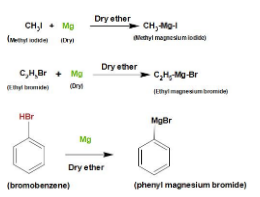
How would you prepare Grignard reagent?
Answer
458.1k+ views
1 likes
Hint: Haloalkanes react with dry magnesium powder in dry ether to form alkyl magnesium halides commonly known as Grignard reagent. It is commonly represented by the general formula
Complete step-by-step answer: Grignard reagent is an organometallic compound because of organometallic bond between magnesium (metal) and alkanes. Grignard reagents are strong bases and strong nucleophiles (that can donate an electron pair). It is very reactive. We know that magnesium is electropositive and it will donate electron pairs to alkane and acquire partially positive charge and alkane acquire partially negative charge.
Polarity creates due to difference in their electronegativity. It becomes a polar molecule. Because of its polarity, it is highly reactive.
To prepare Grignard reagent we will take first alkyl halide (we can take aryl halide also), then We will add magnesium (dry powder) in presence of dry ether.

Mechanism:

The bond between R and X breaks and both R and X take up one electron each. Magnesium have
We can understand this preparation by taking an example. Take methyl iodide and add some dry powder of magnesium in the presence of dry ether. After reaction methyl magnesium iodide will formed.

Note:Keep in mind that everything which we are adding to form Grignard reagent should be in dry form because Grignard reagent reacts with water. Remember that organometallic bond is covalent bond but the bond between magnesium and halogen is ionic bond. Grignard reagent can be stored in dry ether because it stabilizes the Grignard reagent. Grignard reagents are used for making a very large number of organic compounds. Reactivity order should be remembered i.e.
Complete step-by-step answer: Grignard reagent is an organometallic compound because of organometallic bond between magnesium (metal) and alkanes. Grignard reagents are strong bases and strong nucleophiles (that can donate an electron pair). It is very reactive. We know that magnesium is electropositive and it will donate electron pairs to alkane and acquire partially positive charge and alkane acquire partially negative charge.
Polarity creates due to difference in their electronegativity. It becomes a polar molecule. Because of its polarity, it is highly reactive.
To prepare Grignard reagent we will take first alkyl halide (we can take aryl halide also), then We will add magnesium (dry powder) in presence of dry ether.

Mechanism:

The bond between R and X breaks and both R and X take up one electron each. Magnesium have
We can understand this preparation by taking an example. Take methyl iodide and add some dry powder of magnesium in the presence of dry ether. After reaction methyl magnesium iodide will formed.

Note:Keep in mind that everything which we are adding to form Grignard reagent should be in dry form because Grignard reagent reacts with water. Remember that organometallic bond is covalent bond but the bond between magnesium and halogen is ionic bond. Grignard reagent can be stored in dry ether because it stabilizes the Grignard reagent. Grignard reagents are used for making a very large number of organic compounds. Reactivity order should be remembered i.e.
Latest Vedantu courses for you
Grade 11 Science PCM | CBSE | SCHOOL | English
CBSE (2025-26)
School Full course for CBSE students
₹41,848 per year
Recently Updated Pages
Master Class 4 Maths: Engaging Questions & Answers for Success

Master Class 4 English: Engaging Questions & Answers for Success

Master Class 4 Science: Engaging Questions & Answers for Success

Class 4 Question and Answer - Your Ultimate Solutions Guide

Master Class 11 Economics: Engaging Questions & Answers for Success

Master Class 11 Business Studies: Engaging Questions & Answers for Success

Trending doubts
Give 10 examples of unisexual and bisexual flowers

Draw a labelled sketch of the human eye class 12 physics CBSE

a Tabulate the differences in the characteristics of class 12 chemistry CBSE

Differentiate between homogeneous and heterogeneous class 12 chemistry CBSE

Why is the cell called the structural and functional class 12 biology CBSE

Differentiate between insitu conservation and exsitu class 12 biology CBSE




